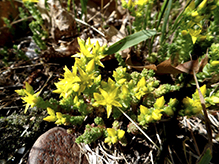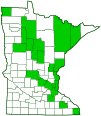goldmoss stonecrop
(Sedum acre ssp. acre)
Conservation • Description • Habitat • Ecology • Use • Distribution • Taxonomy
Conservation Status |
|
|||||||
| IUCN Red List | not listed |
|||||||
| NatureServe | NNA - Not applicable SNA - Not applicable |
|||||||
| Minnesota | not listed |
|||||||
Description |
||
Goldmoss stonecrop is an exotic, evergreen, succulent, flowering plant. It is native to Europe, Asia, and northern Africa. It was introduced, cultivated as an ornamental ground cover, escaped cultivation, and is now naturalized across northern United States and southern Canada. It is uncommon in Minnesota. It is found on beaches, banks of streams and rivers, cemeteries, roadsides, rock outcrops, rock walls, and open disturbed areas. It grows under full sun to light shade in dry areas on calcareous soil. It is drought tolerant and often forms loose or dense mats. Goldmoss stonecrop is perennial forb that rises from fibrous roots. Non-flowering (vegetative) stems are fleshy, branched, round in cross section, and ¾″ to 4″ (2 to 10 cm) long. They are hairless and usually green but sometimes become white with age. They do not have a whitish, waxy coating (glaucous). They lie flat on the ground (prostrate) with just the tips curving upwards (ascending). Where a node contacts the ground the stem produces roots. It may separate at this point creating a vegetative offset, a new plant. Flowering stems are erect or ascending, usually unbranched, and 2″ to 4″ (5 to 10 cm) long or longer. They do not root at the nodes. The leaves are alternate, crowded, and densely overlapping. They sometimes appear to be spiraled around the stem. They are stalkless and are attached slightly above the base, producing a pair of minute, pouch-like spurs below the attachment point. They are thick and succulent, elliptic in cross section, 1⁄16″ to 3⁄16″ (2 to 5 mm) long or longer, and 1⁄32″ to ⅛″ (1 to 4 mm) wide. They gradually and only slightly reduce in size as they ascend the stem. The blades are egg-shaped and bluntly pointed at the tip. The upper and lower surfaces are hairless. They are not glaucous. The margins are untoothed. At flowering time the leaves on vegetative stems are often absent, and the lower leaves on flowering stems are usually white, soft, and papery. The inflorescence is a solitary flower or a branched cluster (cyme) of 2 to 12 flowers at the end of flowering stems. Each flower is about ½″ wide. There are 5 outer floral leaves (sepals), 5 petals, 10 stamens, and 5 carpels, each with a single style. The sepals are green, fleshy, spreading, 1⁄16″ to ⅛″ (2 to 3 mm) long, oblong egg-shaped, and bluntly pointed at the tip. Like the leaves, they have a pair of minute, pouch-like spurs at the base. The petals are bright yellow, 3 ⁄16″ to ⅜″ (5 to 9 mm) long, narrowly lance-shaped, and sharply pointed. The stamens have yellow stalks (filaments) and yellow anthers. The filaments are attached at the bases of the petals. The carpels are greenish-yellow. The fruit is a yellowish, ⅛″ (2.5 to 3.5 mm) long seed capsule (follicle) with many seeds. |
||
Height |
||
Matting: 2″ to 11¾″ (5 to 30 cm) long |
||
Flower Color |
||
Bright yellow |
||
Similar Species |
||
Stringy stonecrop (Sedum sarmentosum) has much longer stems and much longer leaves. They are mostly in well-spaced whorls of three, not crowded or overlapping. |
||
Habitat |
||
Dry. Beaches, banks of streams and rivers, cemeteries, roadsides, rock outcrops, rock walls, and open disturbed areas. Full sun to light shade. Calcareous soil. |
||
Ecology |
||
Flowering |
||
June to July |
||
Pests and Diseases |
||
|
||
Use |
||
|
||
Distribution |
||||
|
Sources |
|||
| 4/22/2023 | ||||
Nativity |
||||
Native to Europe, Asia, and northern Africa. Introduced, cultivated, and naturalized. |
||||
Occurrence |
||||
Uncommon |
||||
Taxonomy |
|||
| Kingdom | Plantae (green algae and land plants) | ||
| Subkingdom | Viridiplantae (green plants) | ||
| Infrakingdom | Streptophyta (land plants and green algae) | ||
| Superdivision | Embryophyta (land plants) | ||
| Division | Tracheophyta (vascular plants) | ||
| Subdivision | Spermatophytina (seed plants) | ||
| Class | Magnoliopsida (flowering plants) | ||
| Superorder | Saxifraganae | ||
Order |
Saxifragales (saxifrages, stonecrops, and allies) | ||
Family |
Crassulaceae (stonecrop) | ||
| Subfamily | Sempervivoideae | ||
| Tribe | Sedeae | ||
| Subtribe | Sedinae | ||
| Genus | Sedum (stonecrops) | ||
| Section | Sedum | ||
| Species | Sedum acre (goldmoss stonecrop) | ||
Synonyms |
|||
|
|||
Common Names |
|||
biting stonecrop goldmoss stonecrop mossy stonecrop stonecrop wall-grass wall-pepper |
|||
Glossary
Ascending
Growing upward at an angle or curving upward from the base.
Carpel
The female reproductive organ of a flower, consisting of an ovary, styles, and stigmas.
Cyme
A branched, flat-topped or convex flower cluster in which the terminal flower opens first and the outermost flowers open last.
Elliptic
Narrowly oval, broadest at the middle, narrower at both ends, with the ends being equal.
Filament
On plants: The thread-like stalk of a stamen which supports the anther. On Lepidoptera: One of a pair of long, thin, fleshy extensions extending from the thorax, and sometimes also from the abdomen, of a caterpillar.
Follicle
A dry fruit formed from a single carpel, containing many seeds, that opens at maturity along the seed-bearing seam.
Glaucous
Pale green or bluish gray due to a whitish, powdery or waxy film, as on a plum or a grape.
Prostrate
Laying flat on the ground.
Sepal
An outer floral leaf, usually green but sometimes colored, at the base of a flower.
Spreading
Extending nearly horizontal.
Visitor Photos |
|||||
Share your photo of this plant. |
|||||
| This button not working for you? Simply email us at info@MinnesotaSeasons.com. Attach one or more photos and, if you like, a caption. |
|||||
Luciearl |
|||||
This pops up everywhere on beaches in the summer, but when people ask me what it is, I have to dig to find the name. One thing for sure, I tell them to pull it up. |
 |
||||
|
|||||
MinnesotaSeasons.com Photos |
|||||
|
|||||

Slideshows |
||

Visitor Videos |
|||
Share your video of this plant. |
|||
| This button not working for you? Simply email us at info@MinnesotaSeasons.com. Attach a video, a YouTube link, or a cloud storage link. |
|||
Other Videos |
|||
| Sedum acre, the goldmoss stonecrop, mossy stonecrop, goldmoss sedum With Adrian in nature |
|||
About
Jun 11, 2019 Sedum acre, the goldmoss stonecrop, mossy stonecrop, goldmoss sedum, biting stonecrop and wallpepper, is a perennial flowering plant in the family Crassulaceae. I go through the forests, mountains, hills, fields, and waters to understand the living world and to create a living mind. I'm just a man who is on passing on this living earth. A living earth that is closer to death, because of us, of the human being. I spend all my time in nature, enjoying its show. All this time I try to make a video encyclopedia with flora and fauna that I encounter on this living earth. Sometimes with human fauna ... I meet wild mushrooms, medicinal mushrooms, edible mushrooms, dead mushrooms, toxic mushrooms, magic mushrooms. Every wild mushroom with its mystery and story. The living earth is still amazing. I meet plants, flowers, trees, shrubs, grass, leaves fallen on the living land, leaves fallen on the dead land, leaves that dance in our thoughts and soul. I meet insects, invertebrates of all kinds, butterflies, worms, larvae, birds, fish, mammals, reptiles, amphibians... But I also encounter deforested forests, hunters, poachers, animals killed, tormented, in a suffering that words can not express. I also meet people who think it is good that they behave like this. I stretch my hand and save an insect from the drowning. But this people trample under foot my hand. They make their choice. I make my choice. Sometimes I manage to correctly identify the species of living beings: mushrooms, plants, animals, insects. Sometimes not. What I know is much less than what I do not know. I am just a man in front of a knowledge that surpasses me, overcomes us. I do not know enough English yet to make my clips more attractive. But I'm learning...A wonderful life, I wish you all! |
|||


Created: 9/5/2020
Last Updated:

